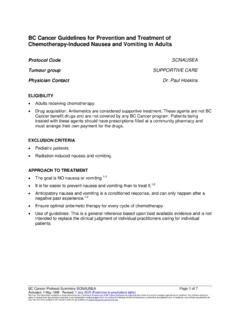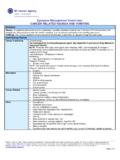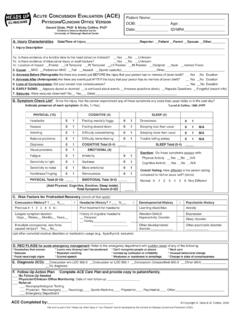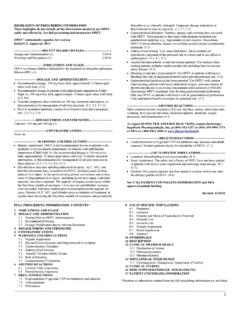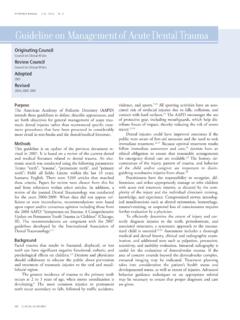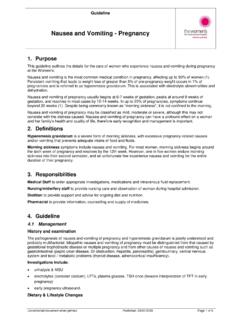Transcription of Managing Opioid-Induced Constipation
1 MMaannaaggiinngg OOppiiooiidd--IInndduucceedd CCoonnssttiippaattiioonn iinn AAmmbbuullaattoorryy--CCaarree PPaattiieennttss Authors: Clyde R. Goodheart, MD, MBA, MS; Stewart B. Leavitt, MA, PhD Medical Reviewers: Lee A. Kral, PharmD, BCPS; Paul W. Lofholm, PharmD, FACA; James D. Toombs, MD Release Date: August 2006 Contents Introduction .. 1 Functional Constipation .. 2 Opioid-Induced 2 Prevalence .. 3 Role of Opioid Receptors .. 3 Differential Opioid Effects .. 3 Patient Assessment & 4 Prevention .. 4 Non-Pharmacologic Tx: Myths & 4 Pharmacologic Tx: Laxatives .. 5 Alternative Pharmacotherapies .. 7 Opioid-Receptor Antagonists .. 7 Selective 7 Prokinetic Agents .. 7 7 8 Introduction Constipation is a frequent side effect of opioids since these agents decrease peristaltic activity in the gastrointestinal (GI) tract.
2 Because of the mechanisms involved in Opioid-Induced Constipation , some treatments that may be applicable for common, functional Constipation are inappropriate for ambulatory-care patients prescribed opioid analgesics. Also in these patients, the distress of Constipation may add to the discomfort already present from pain, and they might decrease or discontinue the opioid to avoid Constipation . So, motivating such patients to comply with their opioid therapy also requires a special approach for Managing Constipation . Constipation as a potential side effect should be considered whenever an opioid medication is prescribed. Managing Opioid-Induced Constipation 2 Functional Constipation Constipation is broadly defined as the passage of hard, dry stools less frequently than the patient s usual bowel-habit pattern (McMillan 2004).
3 Patients and healthcare pro-viders may differ in their assessments of whether the patient is constipated, and fre-quency of bowel movement is not the most critical factor. For example, a group of patients who con-sidered themselves constipated and reported that they had 3 or fewer bowel movements per week for at least 6 months kept diaries of bowel activity for the next 4 weeks. Because the diaries showed that more than half actu-ally had an average of 6 bowel movements per week, the investigators did not consider them as constipated. Regardless of their stool frequency, however, the patients reported difficulty in defecation, which suggests that they considered this a more important crite-rion than frequency (Yuan 2005). Some patients, especially the elderly, ex-pect to have at least one bowel movement each day; otherwise, they believe they are constipated.
4 Other patients may think that having only 2 to 3 weekly bowel movements is not being constipated. Actual frequency of bowel movements in a population of people who are not seeking medical care is ex-tremely variable, ranging from 3 bowel movements per day to 3 per week (Drossman et al. 1982), further complicating assessment of Constipation based on frequency. One literature review indicated that func-tional Constipation is a common problem, af-fecting 12% to 19% of the North American population (Higgins and Johanson 2004). Similar rates of functional Constipation (15%) were found in a study of 10,000 United States adults aged 18 or older (Stewart et al. 1999). Opioid-Induced Constipation Constipation resulting from opioid use is the most common component of a more general condition Opioid-Induced bowel dysfunction, OBD (Yuan 2005).
5 Signs and symptoms of OBD shared in common with functional Constipation include: dry hard stools, straining during evacuation, incomplete evacuation, bloating, abdominal distension, and retention of contents of Practice Pointers Managing Opioid-Induced Constipation Constipation during opioid therapy is common, if not inevita-ble, and may be different from ordinary functional constipa-tion. Clinicians should anticipate the constipating side effects of opioid analgesics and discuss them with patients before starting opioid therapy. Many patients with prior Constipation rely on self-manage-ment and OTC remedies, and they may not mention these to healthcare providers when starting opioid therapy. Given the high variability among patients, characterizing a person as constipated based only on the number of bowel movements per day or week is inappropriate.
6 Prevention is the best approach to Managing Constipation , and an appropriate regimen should be tailored for each pa-tient s needs when beginning opioid therapy. Because treating Constipation is based mostly on clinical or personal experience, common myths and misconceptions exist among clinicians and patients. Available evidence does not suggest that Opioid-Induced con-stipation can be managed merely by increasing intake of flu-ids or dietary fiber, unless the patient is dehydrated or con-suming a fiber-deficient diet. In patients with mild Constipation and little physical activity, moderate increases in activity level, as tolerated, can be beneficial. Bulk-forming laxatives are not appropriate in Opioid-Induced Constipation , because peristalsis is inhibited in these patients.
7 Effective treatment and management of Opioid-Induced consti pation usually requires laxatives; most commonly, a combina-tion stool softener and stimulant. Managing Opioid-Induced Constipation 3the gut. Unlike functional Constipation , OBD also can include cramping, nausea and vomiting , and gastric reflux (Yuan 2005; Talley 2004; Kurz and Sessler 2003; Pappagallo 2001). All of these signs and symptoms result from the actions of opioids on receptors throughout the GI tract (Yuan 2005). Prevalence The reported prevalence of Opioid-Induced Constipation varies among studies. Some use different definitions of Constipation , and others use self-reporting by patients rather than the investigators criteria. In one study, 95% of patients inter-viewed by nurses in a hospital oncology unit reported Constipation as the major side effect of their opioid pain-control regimen (Robinson et al.)
8 2000). A meta-analysis reviewed 11 studies including patients with chronic, non-can-cer pain in whom the effects of oral therapy with potent opioids such as morphine, methadone, hydromorphone, or fentanyl were compared with those of placebo. Constipation was the most common adverse event, experienced by 41% of the 1025 patients in the study (Kalso et al. 2004). Regardless of how prevalence is measured, Opioid-Induced Constipation is a major problem. Some clinicians assume it to be virtually universal in patients who are prescribed opioid analgesics (Hanks et al. 2003). Role of Opioid Receptors The effects of opioid analgesics are mediated by specific opioid receptors. Three well-defined opioid receptors important in humans are mu ( ), kappa ( ), and delta ( ) (Yuan 2005). Activation of mu receptors by an agonist such as morphine can have any of several effects, depending on receptor location.
9 Mu opioid receptors in the brain modulate pain perception and can depress respiratory function, while those in the GI tract decrease bowel motility (Gutstein and Akil 2001). Opioid receptor activation within the bowel wall interferes with normal tone and contractility, delaying transit time of the fecal contents. Increased contractions of circular muscles cause non-propulsive kneading and churning, increasing fluid absorption, which dries and hardens the stool. At the same time, longitudinal propulsive peristalsis is decreased, providing addi-tional time for drying of the stool. In addition to these effects, anal sphincter tone is increased, so reflexive relaxation in response to rectal distension is reduced making defecation more diffi-cult (Gutstein and Akil 2001; McMillan 2004; Yuan 2005).
10 Tolerance commonly develops to opioids during long-term use, requiring increased doses to achieve the same analgesia (Thompson and Ray 2005). Although some tolerance develops to the effects of opioids on gastrointestinal motility, Constipation often persists unless remedial measures are taken (Gutstein and Akil 2001). Differential Opioid Effects Few published reports compare the constipating effects of the various opioid analgesics or evaluate the opioid-related adverse effects associated with specific routes of administration (Hanks et al. 2003). Some controlled studies have shown less frequent laxative use in patients treated with transdermal fentanyl than in those treated with morphine (Radbruch et al. 2000; Ahmedzai and Brooks 1997; Donner et al. 1996; Payne et al. 1998). This finding could be due to the route of administration, or to the adverse-event profile of each opioid; hence, further evaluation is needed.
